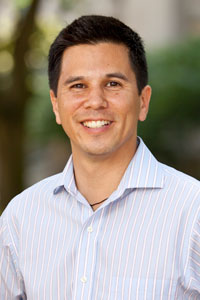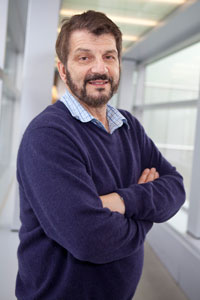News
Projects receiving funding include work by Charles Lieber on biocompatible, injectable electronics (top) and research by David Weitz on the manipulation of microfluidic droplets that can isolate individual cells for analysis (bottom). Image credit: (top) Lieber Research Group and (bottom) Lloyd Ung and John Heyman, Weitz Lab
Cambridge, Mass. – April 27, 2016 – Between academic discovery and product development lurks a lull in research funding that inventors call the “chasm of death,” where a prototype or a proof of concept can feel just out of reach.
To address that development gap, five projects initiated by faculty at Harvard John A. Paulson School of Engineering and Applied Sciences and in the Faculty of Arts and Sciences have been selected to receive funding of between $70,000 and $100,000 each through Harvard’s Physical Sciences & Engineering Accelerator.
The funding is designed to support a burst of activity on a specific project to bring it to a development milestone at which an industrial partner or investor might engage—for example, by sponsoring further research, licensing the technology, or launching a new company.
“The ability to attract an industrial or venture partner is often ‘make or break’ for an emerging academic technology, if you want to see it become a useful product in the outside world,” said Mick Sawka, a director of business development in Harvard’s Office of Technology Development (OTD). “We’ve found that a relatively small amount of very targeted support can help faculty demonstrate that a new invention is ready to break out of the lab.”
Established by OTD in 2013, the Physical Sciences & Engineering Accelerator awards funding annually, through a competitive selection process, to Harvard research projects that have demonstrated some initial results and have clear potential to develop into impactful technologies and products. Over the course of the year, investigators work toward predefined milestones, with access to industry advisors, dedicated guidance from OTD on intellectual property protection, and a comprehensive commercialization strategy that encourages entrepreneurship.
The five projects receiving support from the Physical Sciences & Engineering Accelerator this year are as follows:
Stephen Chong, Professor of Computer Science, has created a shell scripting language, called Shill, that offers strong and flexible security for complex tasks like system administration, through a combination of programming language design and sandboxing technology. Developed with postdoctoral researcher Christos Dimoulas and graduate student Scott Moore, Shill could improve the security of enterprise and cloud-based system administration.
Graduate student Frederick Chang, in the Engineering and Physical Biology Track of the Department of Molecular and Cellular Biology, and his mentor Nancy Kleckner, Herchel Smith Professor of Molecular Biology, have invented a highly sensitive pattern-detection algorithm which, in combination with a suitably designed microscope, will enable three-dimensional time-lapse imaging of living systems at the molecular scale. By giving researchers a better view inside cells, the system could, for example, dramatically enhance the process of evaluating drugs for clinical trials.
Charles Lieber, Mark Hyman, Jr. Professor of Chemistry and Chair of the Department of Chemistry and Chemical Biology, has invented polymer-like mesh electronics and a method of delivering the electronics by syringe injection into living organisms. These biocompatible electronic implants can be used to record activity from and deliver electrical stimulation to the nervous system, and could potentially be used to treat neurological and neurodegenerative diseases.
David A. Weitz, Mallinckrodt Professor of Physics and Applied Physics, has developed a high-throughput microfluidics platform to analyze and sort nanoliter-sized droplets of liquid or gel. These droplets are ideal for functional analysis of individual cells. The platform will enable rapid isolation of immune cells that recognize infected or cancerous cells.
George M. Whitesides, Woodford L. and Ann A. Flowers University Professor, has invented a paper-based respiration sensor that can characterize sleep apnea. Combined with wireless electronics, the sensor could transmit results to a healthcare professional, enabling diagnosis of sleep apnea at home and at low cost, with less need for conventional sleep studies in the initial characterization.
“The research projects stand out for their imagination and creativity,” said Senior Associate Provost Isaac T. Kohlberg, Harvard’s Chief Technology Development Officer. “Each one is challenging the state of the art in science, technology, or health care. The accelerator model we’ve pioneered through the Physical Sciences & Engineering Accelerator and the Blavatnik Biomedical Accelerator takes a strategic approach to advancing technologies like these while they’re still in the lab, incubating them a little longer to ensure they thrive.”
Harvard’s Physical Sciences & Engineering Accelerator has catalyzed the launch of several startup companies in recent years, including Voxel8, RightHand Robotics, Calculario, and Validere, as well as licenses to companies like Green Energy Storage, which is developing a flow battery technology based on Harvard research.
OTD will begin accepting pre-proposals for the next round of funding in mid-summer. The recipients are selected by an advisory committee.
Cutting-edge science delivered direct to your inbox.
Join the Harvard SEAS mailing list.
Scientist Profiles
Stephen Chong
Gordon McKay Professor of Computer Science
David A. Weitz
Mallinckrodt Professor of Physics and of Applied Physics
Press Contact
Caroline Perry


